Negative connotations may spring to mind when ‘SUE’ is heard in conversation. However, airports are increasingly finding this term to be overtly positive. SUE does, after all, help prevent schedule delays, excess costs and even lost lives during construction.
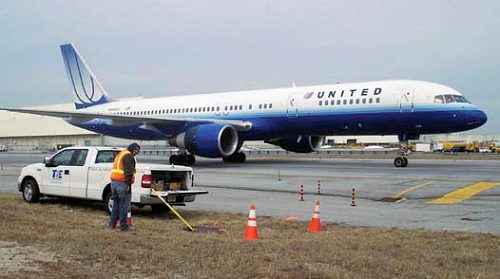
SUE is an engineering-world acronym for Subsurface Utility Engineering. And according to the American Society of Civil Engineers, it has gained considerable credibility as a significant tool to reduce the risk from informational uncertainty associated with underground facilities at construction projects.
The Port Authority of New York and New Jersey (PANYNJ) has been benefiting since the 1990s, when it began using SUE strategies during the modernization of the Central Terminal area at John F. Kennedy International Airport (JFK). It now spends $1.5 million per year for SUE services.
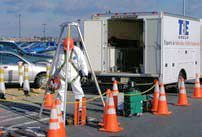 “This goes back years and years in its development and it has been a collaborative process that has evolved to what it is today,” says Jim Steven, program director of Plant, Structures and Airport Redevelopment for the PANYNJ Aviation Department. “Back when we started in the early days of the JFK Redevelopment Program, we recognized we had a vast utility infrastructure and we didn’t really know where a lot of it was. We knew that we had to start to establish some very serious procedures in order to be able to ensure that not only did we keep services to the unit terminal buildings going, but that we were able to manage it, move things and build anew all around that utility infrastructure.”
“This goes back years and years in its development and it has been a collaborative process that has evolved to what it is today,” says Jim Steven, program director of Plant, Structures and Airport Redevelopment for the PANYNJ Aviation Department. “Back when we started in the early days of the JFK Redevelopment Program, we recognized we had a vast utility infrastructure and we didn’t really know where a lot of it was. We knew that we had to start to establish some very serious procedures in order to be able to ensure that not only did we keep services to the unit terminal buildings going, but that we were able to manage it, move things and build anew all around that utility infrastructure.”
Data Feeder
|
Facts and Figures Project: Subsurface Utility Location & DesignationLocation: JFK, Newark, Stewart and LaGuardia Airport Subsurface Utility Engineering (SUE) Consultant: Utility Management System Consultant: CDM Annual SUE Contract: $1.5 million Airport Operator: Port Authority of New York and New Jersey |
With the help of contractor CDM, the Port Authority developed an internal geographic information Utility Management System (UMS) which is fed with data from SUE firms, including the TBE Group. PANYNJ commissions TBE to send field crews to a project site to identify specific coordinate data that is then put into the Port Authority’s computerized utility management database.
John Lentini, JFK project manager for TBE, says the firm has demonstrated time and again how the Port Authority can increase accuracy and glean more information through significant technological advancements within the SUE industry. TBE currently uses global positioning system (GPS) and geographic information system (GIS), as well as traditional total station surveying methods.
“The earlier you bring SUE in, the more benefit you get,” Lentini notes. “If you get in on pre-design, then the design engineers can either design around the utilities that are there, or plan on moving them.”
Contracted by the Port Authority for the past nine years – five in active duty at JFK – Lentini says TBE assisted in the construction of Terminal 6 by identifying many utilities. This helped JetBlue work around, relocate and minimize damage to existing electricity, gas and water lines.
Other projects have included security updates with traffic survey studies and passive intrusion systems. On the latter two projects, the Port Authority needed to run fiberoptic, copper and electric cabling to either traffic devices or posts to install cameras.
Typically, a contractor would be hired to excavate a trench, install conduit and then pull the cable. TBE was able to utilize existing manhole systems and find spare conduit to provide routes for installers.

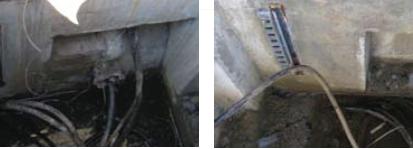
“We would do a confined space entry into these manholes and find an empty conduit system,” Lentini explains. “Once we made sure it was clear, we would install a pull-string through it so that the installer could come back, attach to our string and pull the cable right through. This limited the amount of excavation they would have to do, thereby bringing down the project costs, which saved the Port Authority money.”
Many other techniques are also used, he adds.
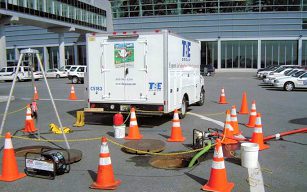
Evolving Strategies
The art of surveying underground utilities has been refined over the years. Without excavating, SUE surveyors can determine depths and crossed utility lines through various electronic sensing sources. Traditional skills, however, are not yet outdated.
“A lot of it is old-fashioned getting out into the field, trying to uncover a manhole, and finding points,” Steven notes. “Just the other day, we had them out taking field verification measurements on a pipe that probably hadn’t been uncovered in 40 years. While we knew where that pipe was because of other electronic sources, we didn’t know how deep it was until we wound up uncovering it. They went out, shot the new depths and that information is being input into the utility management system.”
“We have done a lot of studies on it and we estimate we are saving the Port Authority millions of dollars a year in not hitting utilities and taking things out of service because a contractor dug incorrectly,” Steven says. “We are allowing designers to do smarter, better designs because of that information. We know where things are and we know how to design around them so it is not a problem once we’ve started construction projects.”
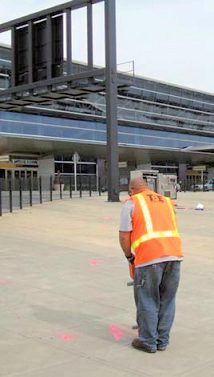 Ongoing Study
Ongoing Study
When the Port Authority started using SUE methods in the 1990s, most of its efforts were concentrated in Kennedy’s Central Terminal area. Now that utilities in that area are mapped through CAD drawings and plans, efforts have shifted elsewhere at the airport.
“We have some great team members here and they are all pulling double duty to get things done,” Steven says, noting an average of two crews with eight to 10 men are out surveying each day. He considers the surveyors the “unsung heroes” of the process.
Steven estimates that JFK is a year away from “having it all nailed down.” Then, the airport will transition to maintenance mode. A SUE program is also beginning at LaGuardia Airport.
“Every time there is a major utility hit and services go down, people say, ‘How can we prevent that from happening again?’ This became a logical evolution of it,” Steven explains.
To date, SUE appears to eliminate these risks.
“My biggest fear is that budget cuts make me stop doing this,” he continues. “I have this phenomenal database right now that is a living, breathing document. We need to ensure we are continually feeding updated information into it. Otherwise it becomes like a dead sea scroll with useless information.”


